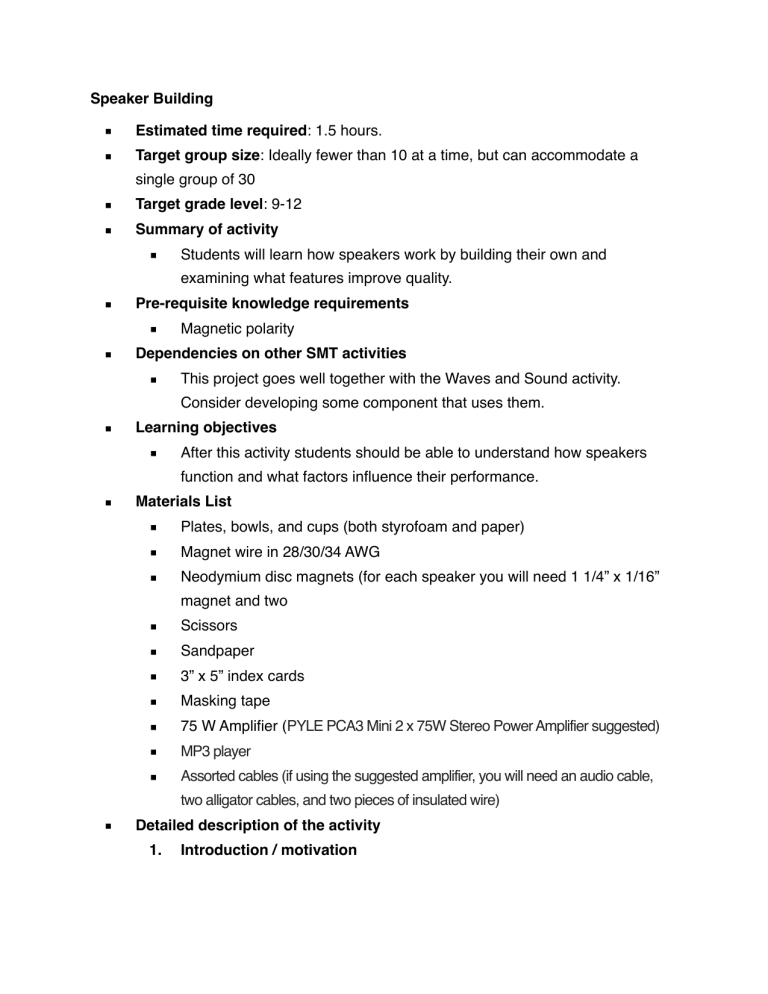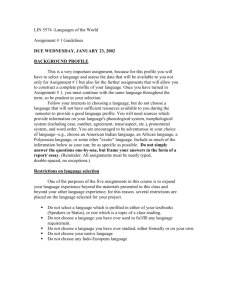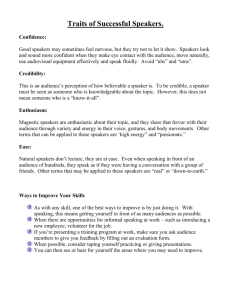Speaker Building ■ Estimated time required Target group size

Speaker Building
■ Estimated time required : 1.5 hours.
■ Target group size : Ideally fewer than 10 at a time, but can accommodate a single group of 30
■ Target grade level : 9-12
■ Summary of activity
■ Students will learn how speakers work by building their own and examining what features improve quality.
■ Pre-requisite knowledge requirements
■ Magnetic polarity
■ Dependencies on other SMT activities
■ This project goes well together with the Waves and Sound activity.
Consider developing some component that uses them.
■ Learning objectives
■ After this activity students should be able to understand how speakers function and what factors influence their performance.
■ Materials List
■ Plates, bowls, and cups (both styrofoam and paper)
■ Magnet wire in 28/30/34 AWG
■ Neodymium disc magnets (for each speaker you will need 1 1/4” x 1/16” magnet and two
■ Scissors
■ Sandpaper
■ 3” x 5” index cards
■ Masking tape
■ 75 W Amplifier ( PYLE PCA3 Mini 2 x 75W Stereo Power Amplifier suggested)
■ MP3 player
■ Assorted cables (if using the suggested amplifier, you will need an audio cable, two alligator cables, and two pieces of insulated wire)
■ Detailed description of the activity
1.
Introduction / motivation
■ Speakers are relatively simple devices, and the basis of this activity is understanding how electrical energy in the form of current can be converted into mechanical energy to produce audio.
2.
Background
■ Speakers have three main components to them:
■ The cone , which will be in our case the plastic or paper cups/bowls.
■ The solid magnet to which the cone is attached.
■ The electromagnet which surrounds the magnet.
3.
Procedure
■ Show students available materials, and briefly suggest possibilities for modifying and improving speakers.
■ Have students make speakers, collating the rings to the back of the cups/bowls which they may modify as they wish.
■ Stop activity 15 minutes before end and have students test their speakers using the amplifier.
■ Have students discuss what might affect the performance of their own speakers. Does a larger cone/more winds/larger diameter wind/etc. improve/degrade sound?
■ Safety Issues?
■ None, as yet.
■ Except for the very strong permanent magnets.
■ Troubleshooting tips
■ Make sure the magnetic coating of the wire is stripped completely when connecting the terminals from the coil of wire to the amplifier.
■ Investigating question
■ How do speakers work and how can we apply our knowledge of transduction to its function?
■ Make sure participants understand the concept of transduction and the changes in forms of energy.
■ Assessments
■ Have students discuss what might affect the performance of their own speakers.






